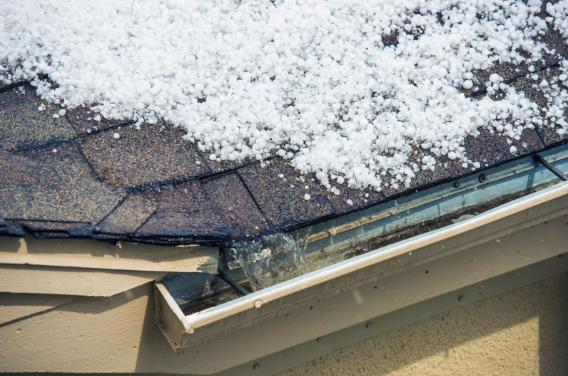Common Causes of Roof Damage

A home is a big responsibility, and the roof that protects it should always be well taken care of. There are several elements that can create issues for your roof, some that are immediate and some that build up over time. Here are the most common causes of roof damage.
Rain and Hail
A proper installation should allow rain to roll off your roof and into the gutters where it is then drained onto the ground. If water can’t drain due to blockage from debris, it will slowly erode roofing materials. Excess moisture can lead to additional problems like mold, poor indoor air quality and water spots on ceilings and walls.
Many shingles can handle normal hail because they are flexible enough to absorb the impact. However, heavy storms that produce large hail can create issues with many roofing materials. Wood shakes, slate and metal may dent and even split after being hit with large hail. Hail damage can be difficult to spot, so it’s best to call a professional to inspect your roof after a storm.
Snow and Ice
Throughout the winter, snow should be able to melt off your roof without any issue. However, underlying leaks may become worse under the snow as it constantly exposes your roof to moisture. Be proactive by making sure you get everything fixed before winter arrives. Ice dams are another enemy to roofs in the winter.
Ice dams develop when heat and moisture from your home cannot escape the attic. Without proper ventilation, the roof becomes too warm. The melted snow flows down the roof and refreezes When it reaches the eaves. This forms what we call ice dams. The blockage can build up and prevent water from flowing off the edge of the roof and into the gutters as it’s meant to. With nowhere to travel, the water can seep into your home and cause water damage. Water also expands as it freezes, which can cause materials to lift out of place and break off.
Wind
Strong wind is a common culprit of roof damage. High winds can lift up the edges of your shingles, leaving your roof exposed to the elements. If the underlayment is exposed, your roof can start to leak. After a windy storm, look around your yard for shingles. If you see any, call a professional to inspect your roof for damage.
Trees
Fallen branches from overhanging trees can puncture through your shingles and create a pathway for water to get into your home’s structure. Leaves and twigs can leave your gutters clogged or can build up on the roof and create moisture for mold to grow.
If you have branches hanging over the roof, algae and moss could potentially transfer over from the tree. Algae will leave the appearance of black streaks all over your roof material. Moss harms your roof by covering it in damp patches that lead to deterioration.
Sunlight
Overtime, your roof’s shingles can break down from ultraviolet (UV) rays. Just as furniture colors fade when left in the sunlight, shingles will experience fading too. The roof can also dry out and crack. This typically happens on older roofs that are reaching the end of their lifespans.
Contact Reader Roofing
If you think your roof has suffered damage from any of the elements we mentioned, now is the time to have it inspected and repaired by a professional. For assistance with your roof, contact Reader Roofing at (216) 451-1355 or fill out our online request form here.


You must be logged in to post a comment.